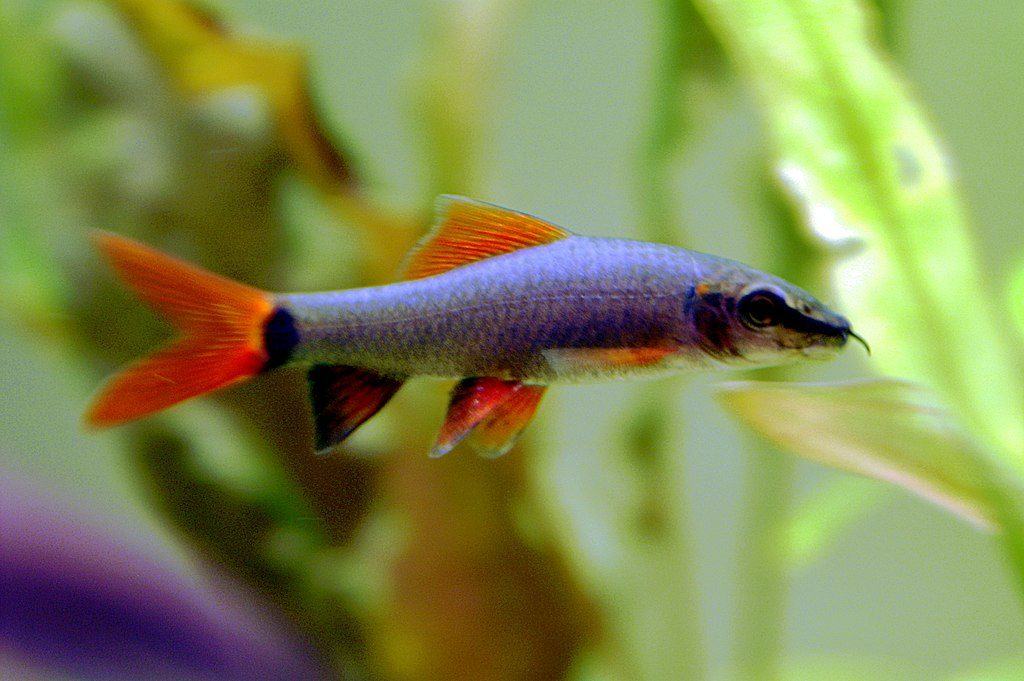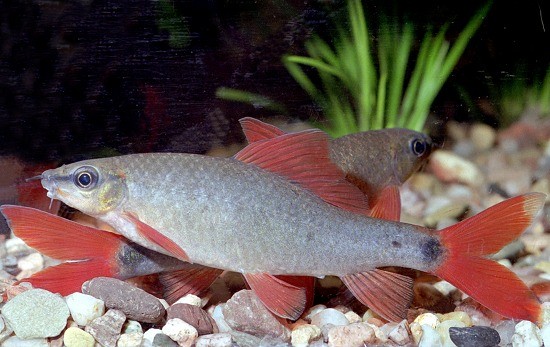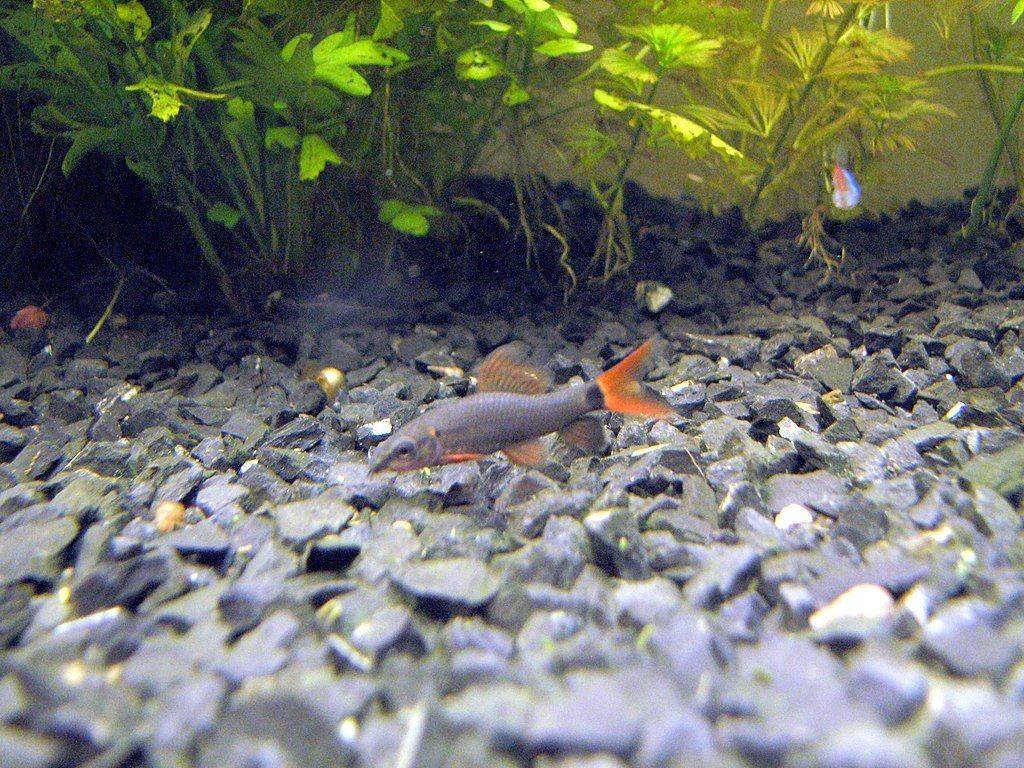Are you looking to diversify your fish tank? Rainbow sharks, as a breed, may be the ideal fish for you to bring into your home or office.
While these fish are more aggressive than average, their unique name and unexpected coloring will make them a joy to view at your leisure. Likewise, these fish are relatively easy to care for, so it will be a breeze for you to include their feedings in your daily routine.

When preparing yourself to get any sort of fish, rainbow shark or otherwise, you’ll want to do your best to be informed.
We’ve gathered together a guide for the care and keeping of your future rainbow shark, to ensure that your fish lives in the most appropriate and healthful environment possible. Take a look!
Contents
Rainbow Shark Stats
When debating whether or not a rainbow shark is the right kind of fish for you, consider the following:
- Size: Six inches.
- Gender: Male rainbow sharks have black coloring on their anal fin, while females do not.
- Ideal Tank pH: 6.5 – 7.5.
- Ideal Tank Temperature: 75 degrees Fahrenheit – 80 degrees Fahrenheit.
- Lifespan: Five to nine years.
- Diet: Herbivore.
The Rainbow Shark: An Overview
Rainbow sharks are most commonly found within freshwater environments in Thailand and Indonesia, like the Chao Phraya or Mekong Rivers.
These ensure that the rainbow shark lives in comfortably warm water and that they have access to nutritious algae.
The rainbow shark tends to move from its common habitat during these nations’ flood reasons, though they migrate back to their preferred rivers come the nations’ dry seasons.
Size
Rainbow sharks are considered a small- to medium-sized fish, but this doesn’t mean they’re necessarily the easiest fish to keep in your home!
A well-cared-for fish, though, is a happy fish, and you’ll be a happier fish owner for the effort you put into your new friend.
How big do rainbow sharks get? Don’t let the name fool you; these little critters aren’t exactly Great White Sharks.
Rainbow shark sizes, in fact, do not tend to vary: these fish are usually six inches in length with triangular snouts and dual-finned tails. This means, despite the breed’s nomenclature, the fish tend to run the same length as the average minnow.
How did the rainbow shark get its misleading name, then? The fish’s dorsal fin resembles that of a shark; because the fin is upright, the discovering biologists associated it with the fish’s larger, more oceanic cousins.
Appearance
If the rainbow shark were still to be judged by its name, you would assume that its coloring would be rather dramatic. In fact, rainbow sharks are not so unusual in terms of appearance.
These fish typically have a dark body and orange fins, though albino rainbow fish are considered particularly unique tankmates.
As previously mentioned, male rainbow sharks have darker coloring along their anal fin; their general coloration, too, is brighter than that of their female counterparts.
Rainbow Shark Care
Tank Requirements
There are a number of different tanks available to you as a fish owner. However, when it comes to rainbow shark care, a larger tank is a better one. Generally, rainbow sharks will thrive in tanks that are fifty-five gallons or larger.
If you’re looking to breed your rainbow sharks, you’ll want to look into tanks that are seventy gallons at the smallest. The extra space is necessary for rainbow sharks to remain unstressed, and also provides additional room for their offspring.
Water Requirements
The pH of your tank’s water is also essential to your rainbow shark’s health. The pH should be kept between 6.5 and 7.5, ensuring that the water is neither overly acid nor too basic.
The temperature of the water, too, should be between seventy-five and eighty degrees in order to mimic the temperature of the rainbow shark’s natural habitat. That is, after all, the environment you are trying to provide for your new companion: one with which the fish is genetically familiar.
Keep an eye on water hardness, as well, when preparing your tank for a rainbow shark; the hardness should be kept between 2 and 15 DH.
Rainbow Shark Food
What do rainbow sharks eat, though? Rainbow sharks are primarily herbivores. They feed on algae in the wild, though you can feed them similarly when keeping them in an appropriate tank.
These algae can come in the form of a tablet or wafer, depending on the preference of you and your fish.
Alternatively, you can feed your rainbow shark lettuce or spinach, so long as the greens have been washed and are free of pesticides.
Some sources will argue that rainbow sharks are also amenable to live food, making them omnivores instead of herbivores.
If you feel like expanding your rainbow shark’s diet, give zooplankton or frozen bloodworms a try. Neither of these sources of food will cause your rainbow shark any harm; rather, if they prove disinterested, you’ll just have to fish the food out of your tank.
Rainbow Shark Tankmates
Rainbow sharks may find themselves wanting for tankmates, as these fish are notoriously aggressive, though primarily towards those of their own breed.
Other potential rainbow shark tankmates will have to be vetted before they make themselves at home, but pairing two rainbow sharks together is likely to guarantee that you witness a fish fight.

Red Tail Sharks are also unwise tankmates to pair with. If you want to ensure that your fishy companion doesn’t get lonely, though, or if you just want to diversify your tank, look into pairing your shark off with loaches, rasboras, or snails.
Loaches are usually the companions of rainbow sharks when both fish are in the wild – which is to say, these two breeds typically share a habitat.
Loaches are not particularly large fish, so they’re not likely to overwhelm your tank, but they are also big enough that your rainbow shark won’t be able to devour them in one bite.
Rainbow sharks, it is worth noting, are bullies; so long as their tankmates are the same size as them, or bigger, said tankmates are likely to survive.
Rasboras are another breed of worthwhile companions with which to pair your rainbow shark. Though these fish are notably smaller, coming in at about two inches in length, they are a breed which is remarkably mellow.
If a rainbow shark invades a rasboras’ space, the rasbora may try and take a bite of the rainbow shark’s fins, but this is unlikely to occur.
Furthermore, your rainbow shark will be aggressive enough that it will keep any particularly bold rasboras in check.
Finally, you can always consider adding a few snails to your fish tank. Not only are snails utterly innocuous, but their hard shells will prevent any ambitious sharks from consuming them.
Whatever compatible fish you bring into your tank, ensure there is plenty of room for both breeds to swim, as well as plenty of rocks and crevices for your fish to hide in.

Ensuring that each breed of fish has the space it needs to avoid the other, if necessary, but also interact, is essential to ensuring the fishes’ health.
Take care, too, to avoid overloading your tank. Keep five or six fish in your tank at a time, but try not to go over; too much company will stress any fish out and increase its level of aggressiveness.
Be warned! “Aggressive” doesn’t just mean that your rainbow shark may have disagreements with some of its tankmates.
Rainbow sharks have also been known to try their fins at flying, now and again – meaning that if they have the opportunity to jump out of their tanks, these crafty fish will take it.
Ensure that your tank has a hood that fits well, and you shouldn’t have to worry about any flying fish.
Breeding
The rainbow shark’s temperament does make breeding a challenge – again, because the rainbow shark is especially aggressive towards members of its own breed.
Rainbow sharks reach sexual maturity when they are roughly four inches in length, and they tend to lay eggs or spawn when the weather grows cooler.
In the wild, the fish would not have to interact with their breeding partner; when in a tank, things become a little more difficult.
It is recommended that rainbow sharks kept in the home be exposed to hormone injection, should the owner of the fish be in the midst of coaxing them to breed.
Take care to ensure that your breeding fish are in a larger-than-usual tank; the eggs, once they have been fertilized and hatched, will invite dozens of fresh and aggressive rainbow sharks into your controlled environment.
This means a greater population for you, yes, but also puts the fish at risk for overly-aggressive behavior.
Check out the video below for extra information on rainbow shark care.
Rainbow Sharks Conclusion
Rainbow sharks are relatively easy to take care of, when compared to other fish, so long as you ensure that you make their environment as comfortable as possible.
Before seeking out a rainbow shark, consider what essentials you need to bring into your home. Do you have room for a larger tank? Do you have a reliable source of the algae these fish prefer?
If you’re bringing rainbow sharks into a pre-existing tank, are you certain that the pH will be to their liking and that their future tankmates aren’t destined to become future meals?
It may seem like a lot of work, but by laying out a positive foundation, the keeping of your rainbow fish will be all the easier.
Do you have any tips on Rainbow Shark care?


